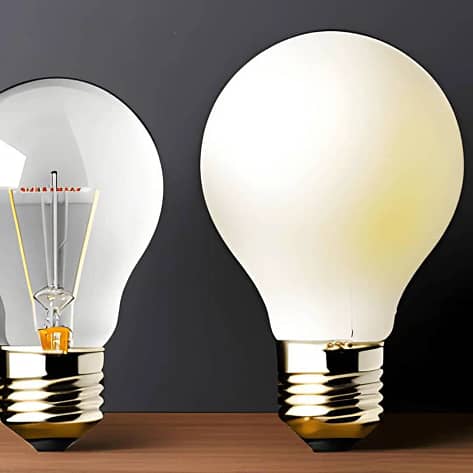As a homeowner, understanding the difference between A19 and E26 bulbs can be beneficial in the long run. Light bulbs are a crucial component of any home’s lighting system, but with so many different types and options available, it can be confusing to know which bulbs to choose.
The two types I’ll be touching on in this post are the A19 and E26. These terms refer to different aspects of a light bulb, but many often use them interchangeably or misunderstood.
In this guide, I’ll explain the difference between A19 and E26 bulbs, what each term means, and which type of bulb is best for different lighting needs.
Whether you’re looking to replace a burnt-out bulb or upgrade your home’s lighting system, understanding the differences between A19 and E26 bulbs can help you make an informed decision and choose the right bulb for your needs.
Let’s begin!
What are A19 light bulbs?
The term A19 refers to the shape and size of the bulb, and is roughly the same shape as a standard household incandescent bulb.
The letter A in A19 stands for “arbitrary,” which means that the bulb shape is not standardized by any specific organization or agency. The number 19 refers to the diameter of the bulb in eighths of an inch, so an A19 bulb has a diameter of 19/8 or 2.375 inches at its widest point.
Next, what are E26 light bulbs?
E26 is a type of base or socket used for light bulbs, particularly in North America. The E stands for “Edison,” the inventor who created the first commercially viable incandescent light bulb, Thomas Edison. The number 26 refers to the diameter of the base in millimeters, so an E26 base has a diameter of 26 millimeters.
The Key Difference Between The A19 And E26
Bulb Shape and Size:
As mentioned previously, the A19 bulb has a standard bulb shape with a diameter of approximately 2.375 inches and a length of around 4.13 inches. The E26 bulb, on the other hand, refers to the base size of the bulb rather than its shape and you can find them in a variety of sizes
Socket Compatibility:
One of the most significant differences between A19 and E26 bulbs is their socket compatibility. A19 bulbs can fit into a variety of fixtures with a standard medium base (E26) socket. However, not all E26 base sockets are compatible with A19 bulbs. Some fixtures may require a larger or smaller bulb base, such as the candelabra base (E12) or the mogul base (E39).
Light Output:
The light output of a bulb is measured in lumens, and it refers to the amount of visible light that a bulb emits. A19 bulbs have a higher light output than E26 bulbs, but this can vary depending on the specific type of bulb. A standard 60-watt A19 bulb produces around 800 lumens, while a 60-watt E26 bulb produces around 750 lumens.
Wattage and Energy Efficiency:
Wattage is a measure of the amount of power that a bulb consumes and determines the brightness of a bulb. A19 bulbs can consume more power than E26 bulbs, as they have a higher wattage rating. Yet, this also means that A19 bulbs are generally less energy-efficient than E26 bulbs. If you are looking to save energy and reduce your electricity bills, choosing an E26 bulb with a lower wattage rating is the way to go.
Price and Availability:
Because A19 bulbs are widely available, you can purchase them at most home improvement stores and online retailers. They are also generally more affordable than E26 bulbs. While E26 bulbs are harder to find, and you can use them in specialty lighting fixtures, such as pendant lights and chandeliers, and are available in a wide range of styles and designs.
Can an E26 Bulb work in an A19 socket?
Yes, an E26 bulb can work in an A19 socket. In fact, the A19 socket should accept bulbs with a medium E26 base. It’s important to note that not all bulbs with an E26 base are the same size or wattage, so it’s always a good idea to check the manufacturer’s specifications to make sure that the bulb you choose is compatible with your fixture.
Additionally, if your fixture is rated for a specific wattage, be sure to choose a bulb that is rated for the same wattage or lower to avoid damaging the fixture or creating a fire hazard.
What Should You Buy?
As a homeowner looking to buy a bulb, it’s vital to understand that A19 and E26 are not actually two different types of bulbs, but rather two different aspects of a bulb. A19 refers to the shape and size of the bulb, while E26 refers to the type and size of the base.
Generally, if you’re looking for a bulb that will fit in most standard light fixtures, an A19 bulb with an E26 base is a good choice.
However, the bulb you choose will depend on your lighting needs and preferences. For example, if you’re looking for a bulb that is more energy-efficient and longer-lasting, you may want to consider an E26 bulb. Always read the manufacturer’s specifications carefully and compare different bulbs to find the one that will work best for you.
Wrapping up
By understanding the differences between A19 and E26 bulbs, you can select the best bulbs for your home that will provide the right amount of light while being energy efficient and compatible with your fixtures.




